last update on September 10, 2003
file name: I-230.html
On February 26, 1943 the OKB was charged to develop an improved MiG-3
for the PVO, with the following requirements:
-
take off weight 3100 kg
-
top speed 670 km/h;
-
ceiling 12500 m;
-
climb time to 10,000 m 13 minutes.
The aircraft was called MiG-3U (uluchshennyi, improved).
To reach such goals, an accurate study of all the parts to save weight.
The main differences of the MiG-3U respect to the standard MiG-3
were:
-
the fuselage was leghtened and had no central welded truss, but it was
an all-wooden monocoque structure with a plywood skin of 3 layers 1 mm
thick in the wing centre section, and two layers in the tail (not a veneer
skin like that of the basic MiG-3); this lightened and simplified the structure;
-
the cockpit was moved back and raised, and its canopy was widened and raised
to improve visibility;
-
the main spar of the wing was no longer interrupted by the cooler tunnel;
-
main spars of the wing outer panels were no longer made of wood, but of
metal;
-
flaps were fitted with lockers for extracted position;
-
wingtip position lights were moved;
-
the stabilizer and rudder were modified;
-
the horizontal tail surfaces were lifted 200 mm to avoid interference with
the new tail wheel mechanism;
-
the main landing gear was reprojected with different doors and smaller
wheels 600x180;
-
the armament was composed by two 20 mm ShVAK guns with 150 rounds each,
placed over the nose and syncronized; they could fire both separately and
in couple;
-
the P-310 water cooler was placed inside the fuselage, below the cockpit;
its main air intakes were located in the wingroots, while two auxilary
intakes were located in ventral position, on the sides of the oil cooler
tunnel;
-
the air intakes of supercharger were still in the wingroots, with the water
cooler intakes;
-
the oil cooler "533" was put in a ventral tunnel between the wheel bays;
|
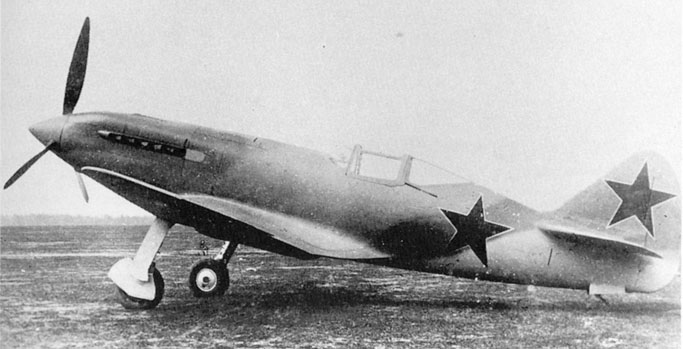
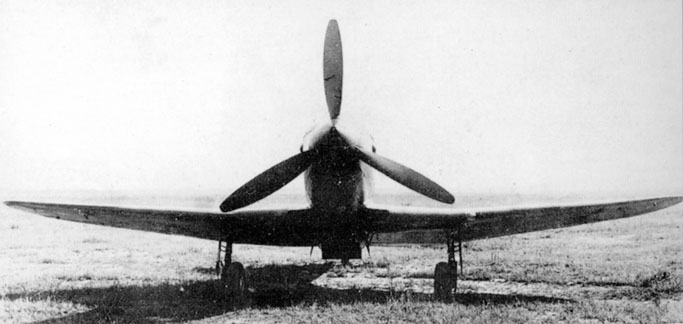
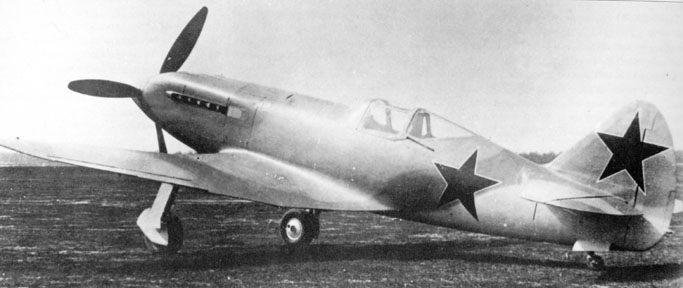
|
-
the radio set was composed by a RSI-3 transmitter and a RSI-4 receiver;
-
the gunsight was a PBP-1A;
-
a new control column incorporating the brake lever, fire control button
and press-to transmit button was installed;
-
the oxygen system was KPA-3bis and a 4 liters bottle;
-
the access to radio and oxygen equipments was from the hatch on the right
side of fuselage;
-
the engine was an AM-35A with reduction 0.732, built with spare parts (of
AM-35A and of AM-38) because of engine shortage; it was 40 kg heavier than
the standard AM-35A;
-
the propeller was a AV-5L-126A, with a 3.2 m diameter;
-
a 440 l bladder-type fuel tank, contained on a box of flame-resistant plywood,
was installed between engine and cockpit;
-
it should be possible to install two further tanks in the wings, for further
210 litres.
The first prototype D-01 was first flown by the test pilot V.N.Savkin on
May 31, 1943. During June and July furter 5 fighters were built, named
from D-02 to D-06.
D-04 had a larger wing, with a span of 11.14 m and a 18.22 mq area.
The D-01 completed 28 flight tests, showing problems of engine overheating,
particularly of oil.
D-01 was transferred to NII-VVS on 23 July for state tests; they were
from 28 July to 6 August, led by chief engineer captain A.S. Rozanov and
test pilot B.I. Khomyakov.
The tests showed a top speed of 656 km/h at 7000m, a ceiling of 11.900
m; the time to turn right was 35 s, to turn left 37 seconds; the combat
turn was made in 22 s on both sides, and involved an altitude increase
of 400-450 m.
The acrobatic performances of the D-01 were good, but the landing remained
difficult; the cockpit was more comfortable and similar to other up-to-date
fighters.
Some vibrations were noted on the tail horizontal surfaces.
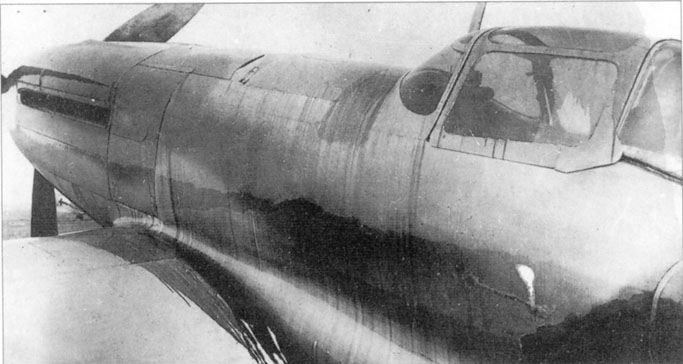 |
The most evident defect was the oil leakage through the coupling of
the reductor shaft, especially at high altitude.
After every flight, the aircraft returned with the fuselage sprayed
by oil from the nose up to the tail.
This defect was considered unacceptable by test pilots, but it was
probably due to the hybrid engine. |
D-01 returned at OKB-155 for corrections. Then all the prototypes were
proposed to the 12 GvIAP for operative tests.
They were tested on fly by Leytenant P.A.Zhuravliov and checked by
technicians of 12 Gv.IAP.
Only D-01,D-03, D-04 and D-06 passed the controls and were accepted
by the unit, while D-02 and D-05 remained at OKB-155 to change the engines.
Original engines AM-35A arrived only on October 10.
While waiting, D-02 received longer wings. After the installation of
the engine, D-02 was transferred to 177 IAP, while D-05 had still oil leakages
and was transferred to Zavod n.34 to remedy.
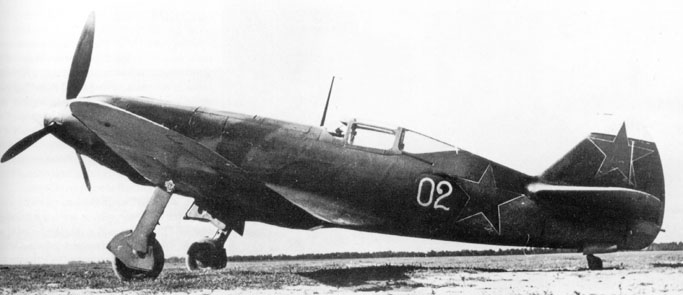 |
Here are three photos of a prototype numbered white 02.
This has the radio mast.
It looks painted AMT-11 light grey and AMT-12 dark grey, with AMT-7
undersurfaces.
Note the position lights, now placed above and below the wing surfaces
(as for La-5) instead than on the wingtip edge (as for usual MiG-3). |
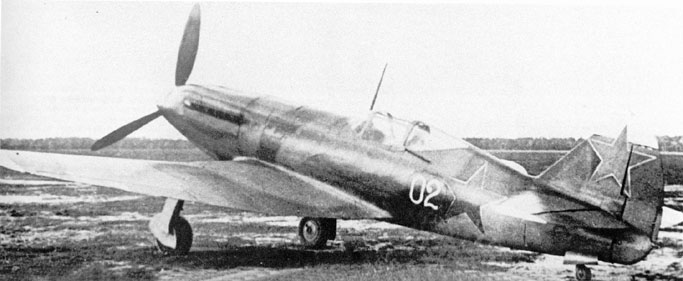 |
Note the silver outlines of stars, and the white tips of tail and wing
tips.
The black propeller blades look to have yellow sprayed tips.
The tail wheel doors are not yet bulged as were those of late MiG-3s. |
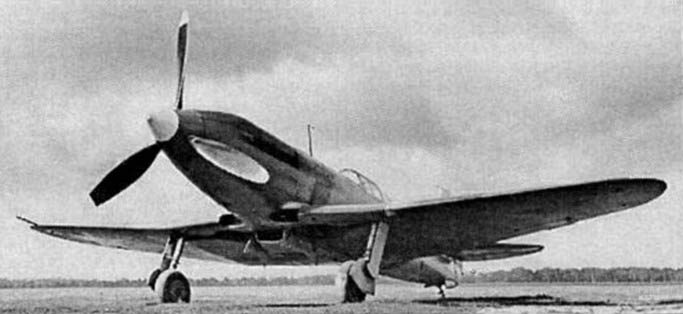 |
Note the white spinner and blades tips.
Here we see the ventral air intake for oil cooler, located between
the undercarriage bays; it ends with a movable flap.
The water cooler is located behind the oil cooler, and it is wider
than it.
It receives air both from the wingroot intakes and from two smaller
intakes on its sides (behind the wheel doors to avoid interference with
undercarriage).
Its outlet is closed by another wide flap.
Wingroot intakes are both for water cooling and for the supercharger
inlet. |
This example (D-01 after modifications) is resemblant to the
previous one, but with different camouflage scheme and without digits or
white tips.
The photo shows both the oil cooler flap (close to the wheel bay door)
and the water cooler outlet flap (close to the wing flaps) |
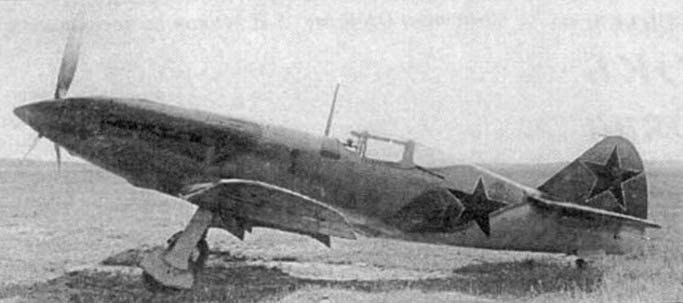 |
New exhaust stacks are clearly visible here; they are vaguely resemblant
to those of Yak-3.
The nose was reshaped, with different paneling and a sharper spinner.
Again, we see both oil cooler flap and water cooler flap in lowered
position. |
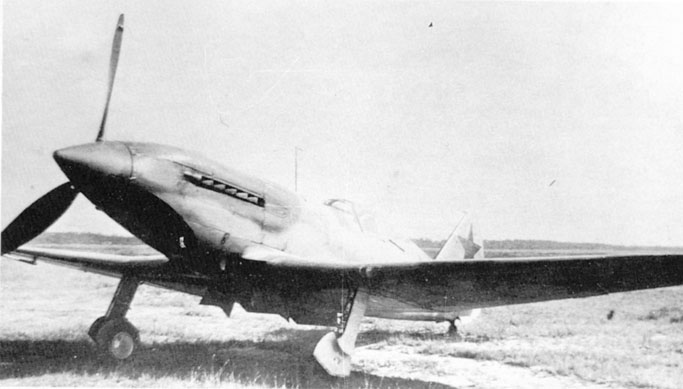 |
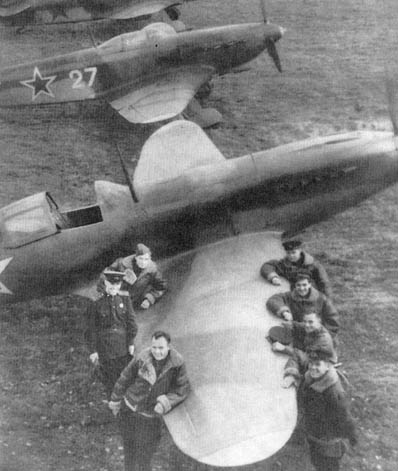 |
The D aircrafts of 12 GvIAP reached some limited subcess, for example,
during 1942/43 German high-altitude reconnaissance planes Ju-86 sometimes
flew safely over Moscow, at the altitude of 13 km where they were unreachable
for fighters or AA fire.
Once two pilots from 12 GIAP, Edik Nalivaiko with an high-altitude
Yak-9D and Lionia Samohvalov with a Mig-3U, succeeded to get 1 km close
to a Ju-86, without reaching it. Nevertheless, after that, such flights
over Moscow were stopped.
All D aircrafts were retired by service after some months, due to the
already mentioned problems, particularly to the difficulties while landing,
that led to wreck two aircrafts.
Here we see the line of fighters under the command of M.E. Cyganov of
the 12GIAP, 1943.
On the left: V. Volohov, M. Cyganov, A. Igoshin. On the right: G. Fastovec,
S. Mikoyan, Kosarev
below: the same line. A woman is showing something to the MiG's
pilot.
This MiG looks to have the same camouflage of the Yaks, that is to
say AMT-4 green with blackish bands, amd AMT-7 light blue undersurfaces;
stars have white outline.
The third aircraft (Yak-7) looks to have silver or yellow outlines
instead than white ones. |
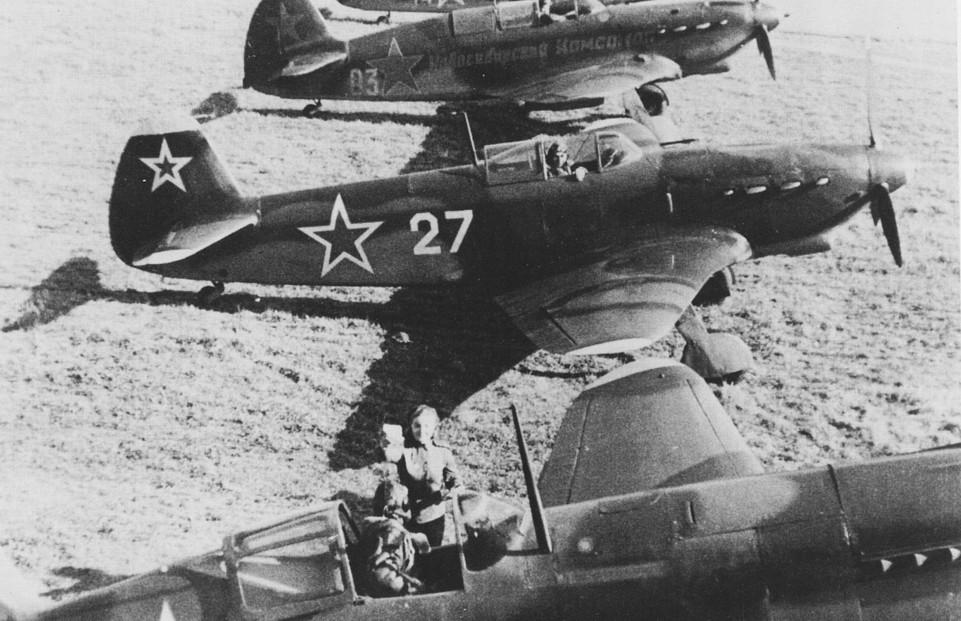
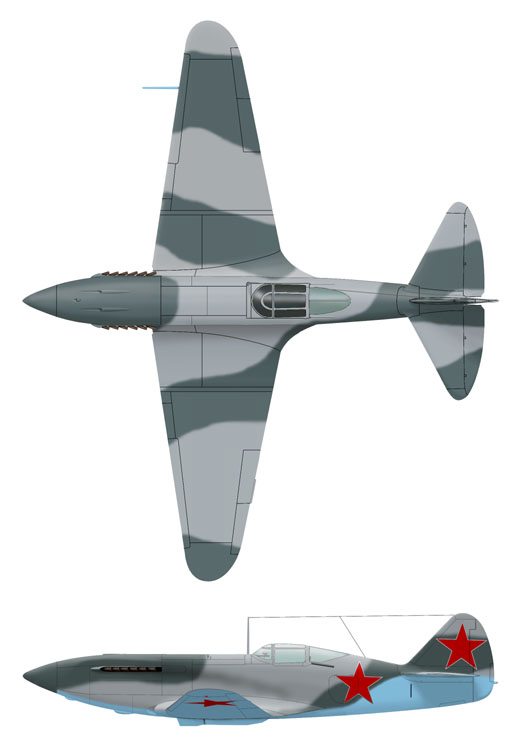 |
This 3-view color drawing is still provisional; frontal and ventral
view have still to be added, and some corrections have yet to be made on
shape and details.
It is drawn on the basis of some drawings derived from Shavrov's book,
as all the existing 3-views of this aeroplane (except for the profile in
the Hazanov's monograph on MiG-3).
At present time, only the book MiG-flugzeuge of K.H. Eyermann shows
a ventral view of this aircraft, but it is wrong in interpretation of ventral
radiator (the oil cooler is missing), in undercarriage bays shape (they
should be inclined slightly rearward at the center) and probably in wing
flaps shape (shown reptangular as on Yaks, while they were probably as
on usual MiG-3s). |
Here is another drawing available on bibliography, derived from Shavrov's
sketches too. Some corrections were made on the wing platform, position
of lights, air intakes and trim.
When printed with the appropriate 72 dpi resolution with a photo elaboration
program, this drawing should be in approximate 1/72 scale. |
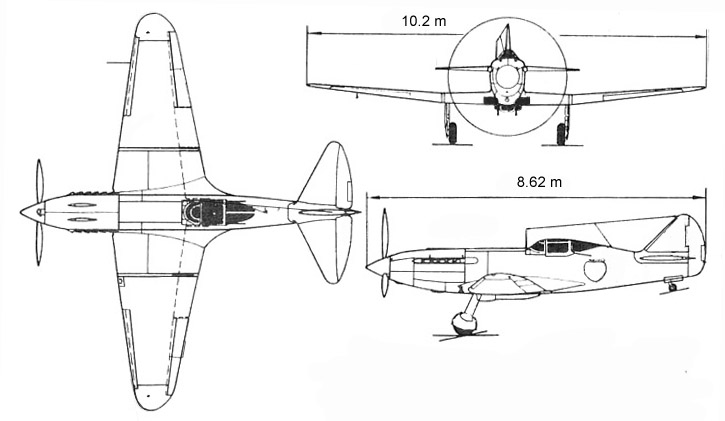 |
Modelers could be interested in this comparison between the profile
of I-230 and of MiG-3 for an 1/72 model:.
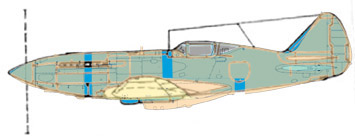
When printed with the appropriate 72 dpi resolution with a photo elaboration
program, this drawing should be in approximate 1/72 scale.
|
-
the fuselage has to be leghtened 2 mm in the nose, plus 3 mm behind the
wing (the cut has to be made in such a way to move the canopy 3 mm back);
-
the ventral profile has to be reshaped to become straighter;
-
the canopy should be slightly raised and reshaped, with the rear window
enlarged (omitting rear frames painting); an Emhar canopy could be taken
as a base;
-
the profile of stabilizator should be extended; other modifies have to
be made on the rudder;
-
the tail horizontal surfaces have to be moved 3 mm down, and slightly modified
in profile; Zvezda tail plans are more resemblant;
-
a slightly longer and sharper spinner is needed;
-
the side oil coolers have to be removed (you have to fill the fuselage
from inside first, to avoid perforation);
-
Yak-3 exhaust stacks can replace the original ones;
-
new undercarriage bays, undercarriage, wingroots air intakes, position
lights, oil and water coolers, gun fairings and all the new panel lines
have to be made.
|
Notes about painting:
Some I-230 looks to have been camouflaged with AMT-11 light grey and
AMT-12 dark grey bands, with AMT-7 light blue undersurfaces, with silver
outlined red stars on 6 standard positions.
At least one example in service with the 12 GIAP appears to be painted
with the same colors of Yaks, that is to say AMT-4 green with blackish
bands, and AMT-7 light blue undersurfaces; stars had white outline.
The propeller blades look black with white or yellow tips, sometimes
sharply painted, sometimes soft sprayed.
The undercarriage legs, their covers ant the wheel disks appear silver
or, more rarely, light blue, while the central doors, and probably the
bays, looks light blue painted.
|
MiG-3 late type |
MiG-3U (D, I-230) |
| first flight |
June 1941 |
May 1943 |
| built |
about 1,600 |
6 |
engine
type |
AM-35A |
hybrid AM-35A/
AM-38 |
| power |
1,350/1,600 |
1,350 hp |
Max speed
with closed canopy |
640 km/h
at 7000 m |
656 km/h
at 7000 m |
| max speed at sea level |
466 km/h |
505 km/h
(526 with boost) |
| ceiling |
12,000 m |
11,900 m |
| climb to 5,000 m |
7'07'' |
6'12'' |
| lenght |
8,25 m |
8,62 m |
| wingspan |
10,2 m |
10,2 m |
| wing area |
17,6 sq.m |
17,44 sq.m |
| empty weight |
2600 kg |
2600 kg |
| gross w. |
3350 kg |
3260 kg |
| fuel |
350 kg |
440 l (fuselage) + eventually 210 l (wingroots) |
| range |
820 km |
1.350 km |
| fixed armament |
1x12.7 mm UBS + 2x 7.62 mm ShKAS
or 2x12.7 mm UBS or 2x 20 mm ShVAK |
2x 20 mm ShVAK |
| fall or launch armament |
6x 82 mm rockets
or 2x100 kg bombs
or 4x25 kg bombs |
? |






